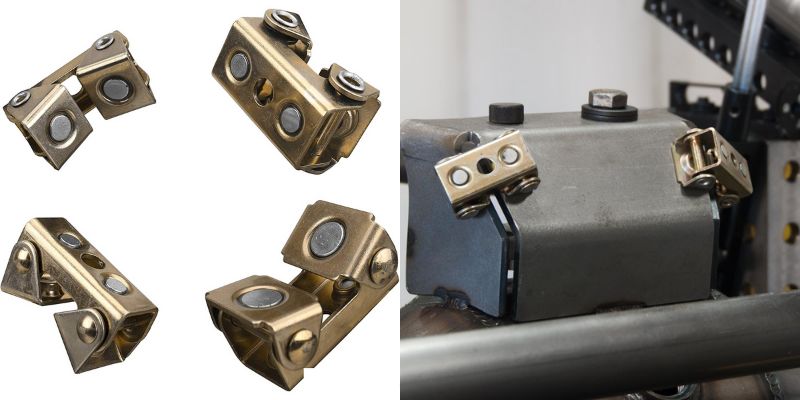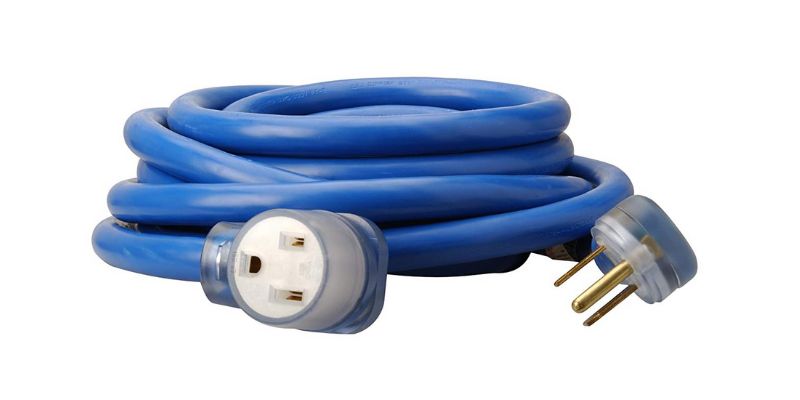There are many methods or ways to join two or more metal pieces together, yet one of the methods that produce the strongest joint is welding.
To carry out a weld, you need a machine that will melt the two metals in contact, allowing them to join when the heated joint cools down. The machine however, is not the only tool you need. There are many other welding tools we’ve listed here that will make your work easier and free from errors.
Whether you’re beginner or pro, going through this list can help you pick the right tools or update the ones you already have, so that your next welding project can go a lot smoother.
These tools will not only make your projects easier, but will also enhance the quality of your work.
Table of Contents
1. A welding machine

One thing’s for sure. You can’t weld 2 pieces of metals together without a welding machine. As a pro, this machine is one of the first tools that should grace your workshop.
Although there are different types to choose from, you should always go for the one more suitable for the project at hand.
There are MIG welding machines like this powerful Hobart Handler shown in the image above, TIG, resistance, laser welding machines and so on.
Your choice should always be guided by the type of project you want to handle and the reliability or quality of the machine.
2. Welding table
Just like you need a workbench for your woodworking projects, you also need a workbench or table when carrying out welding projects.
Your normal wooden or plastic workbench will not work here because welded joints get very hot and will burn a wooden or melt a plastic workbench. So, try getting a steel workbench instead.
It provides you a platform for you to place and weld your work piece. Talking about welding tables, this Kastforce KF3002 shown in the video above is one of the best ones you can get for your projects.
Along with the table, the Kastforce comes equipped with a storage tray below the table top where you can store other tools and items.
3. Welding helmet
A good welding helmet will protect everything in your face, including your eyes, nose and ears. Welding a piece of metal can produce a very bright light, very harmful gases and a very loud sound or noise that is harmful to your eyes, respiratory system and your hearing.
With a good helmet, you can protect yourself from the harmful light, gases and sound produced as you melt and join the metal pieces together.
4. Air Needle Scaler

An air needle scaler is a very important tool for welding. It’s a simple pneumatic tool made up of several set of fine chisels called needles, which are forced at varying speeds up to 4000 or more strokes per minute.
The purpose of this is to clean off the surface of the metal of any foreign material like rust, dirt, mill scale and even old paint.
Welders primarily use it to clean off excess slag from a material being welded.
5. Chipping Hammer and Wire Brush

Instead of an air needle scaler, sometimes when removing welding slag, the most effective tool you’ll need is a chipping hammer.
By simply raking it through the joint created, you can easily remove the slag left behind.
Unlike a regular hammer, both ends are sharpened. One side is wedged flat like an axe while the other side of the hammer is pointed. Most of the time, the flat wedged or beveled face is easier and more effective to use on most surfaces.
The pointed side is more effective when you have to chip off slag from a hollow weld or surface where the flat beveled face cannot be used.
Whether you’re starting out as a beginner or you’re already a pro, a chipping hammer is surely one of the tools you need in your toolbox to keep your welds clean and free from slags.
6. Wire / Sheet Metal Thickness Gauge

The thicker a material is, the greater amount of heat it absorbs before melting. That is why it’s very important to measure the thickness of the metal materials you’re welding.
That will tell you how to set up your welding machine so matches the material you’re working on. Of course you can always use a vernier calipers to check this thickness, but that will take some time. Using a sheet metal thickness gauge like the one shown is my favorite way to check sheet metals and wire thickness because it’s faster to use.
The different thicknesses are engraved on the side so you can read it easily. It’s made with stainless steel, so won’t rust lose its accuracy no matter how long you use it.
7. Arrow Welding Magnets

These arrow welding magnets allow you to hold two metal pieces together correctly at the right angles so they can be welded together.
The arrow shape design of the holder makes it easy to work at common angles like 45, 90 and 135 degrees.
8. Grasshopper welding finger
Welding very small parts together like nuts, bolts and thin plates can be quite difficult because they’re not easy to hold together.
Using this grasshopper welding finger from Strong Hand Tools however, you can easily hold them together with accuracy.
It’s a very nifty tool you’ll surely have use for during your projects.
9. Angle grinder

Angle grinders are very important welding tools. The result of joining one or two pieces of metal together through welding does not always result in a smooth joint.
With the angle grinder you can smoothen out the joint and produce the type of surface you need for your project.
Apart from smoothing the surface, it’s also very useful for metal cutting.
10. Steel cube welding kit

This is not actually a tool, but it’s a training kit consisting of 6 perfectly cut squares you can weld together to form different shapes while testing and honing your welding skills.
11. Welding positioner turntable

With the aid of a chuck, you can clamp your workpiece to this welding positioner turntable so you can weld at various angles.
The turntable can be turned from 0 to 90 degrees and can also be fixed with the aid of tilt lock wrenches at any of these angles.
12. Welding fume extractor

Get rid of the dangerous fumes created while welding with this Baoshishan fume extractor. The suction strength of the fume extractor can be adjusted according to the amount of fumes produced using a simple fan switch.
The extractor draws in the smoke or fumes generated during welding or soldering and discharges them away from the area of operation where they’re no longer harm anyone.
It comes equipped with a LED lamp which illuminates your work area allowing you to see your workpiece clearly.
13. Black Kevlar protective arm sleeves

These are 22 inch long protective arm sleeves you can wear during your projects. They’ll protect your arm from heat and they’re also cut resistant.
It’s essential that you have these with you all the time if you engage in welding or other construction projects where large amounts of heat is created and dissipated.
14. Rockwell jawhorse sheetmaster

The Rockwell Jawhorse is a hands-free clamping solution you can use to clamp any type of material as wide as 49 inches using up to 1 ton of force.
With the Jawhorse, you can clamp materials as heavy as 600 lbs without any hiccups. It’s a must-have tool every professional welder should have.
15. Contour wrap-a-round pipe marking tool

Measuring 3.88 inches to 4 feet, this contour wrap-a-around marking tool by Jackson Safety is all you need to make straight lines and mark pipes during your welding projects.
It’s made from flexible gasket material which is resistant to heat and cold, and thus will not get damage easily due to heat generated during welding.
16. Roll cage impact resistant welding gloves

This glove from Lincoln Electric not only withstands heat from welding applications, but it’s also impact resistant as well, because it’s equipped with high temperature rated silicone hand and finger reinforcements.
The leather exterior plus an internal hand liner made of closely knitted Kevlar fabric and numerous leather reinforced stress points on the hand glove ensures that it is resistant to cut.
When you put it on your hands, they are protected from heat, flames, spatters and sparks generated during welding applications.
17. Adjustable magnetic V-pads

With these adjustable magnetic v-pads, you can hold and position light workpieces for light duty and tight spot holding welding applications.
These v-pads will ensure are able to position and weld materials together accurately every time.
18. Welder extension cord

This is a 25 ft. 8 gauge welder extension cord by Southwire. The weire is rated at 40A, 250V and 10,000W.
With this wire, you can offer more portability to your welding machine. Use it father than the normal cord would have allowed.
It’s a high performance wire molded at the ends, offering more safety and usability to your welding machine. It also features lighted receptacles at the ends that indicates when the power is on.
19. Welding apron

Made of 100 percent heavy duty genuine leather, this heat and flame-resistant welding and work apron from Qeelink will protect your body from the sparks, flames and heat created during your welding projects.
It’s made of thick spit cowhide and sewn together with strong, heat resitant Kevlar thread for durability and protection during work. 6 tool pockets ensures your hand tools are just an apron pocket away from you.
20. Cast Iron Welders Clamp

One of the most common joints you’ll make as a welder is a 90 degree angle joint. What better way to make sure they’re accurate every time than to use this cast iron angle clamp.
Apart from making sure your pieces are at 90 degrees, the clamp also holds them securely, keeping them from falling apart as you carry out your weld.


I disagree with the advice about necessity for most of these special tools for welders . All through my apprenticeship we used only the very basic aids and Ppe’s The time will come where the job so excludes any particular tool and if you haven’t trained to work with the mere basics You’re up for a big challenge – disadvantaged at the start.
For example : Building up locomotive wheels for machining, we mounted the axles on two blocks either side and after preheat would use our feet to turn the wheel in sync to the deposit rate of the electrode. 2 . The traditional shield was a manual operation – shield up ( yoke head strap on head) shield down -nod or touch down to start weld.
This article does not discourage the use of basic welding tools or does not imply that these are the only tools you can use so you can work at the best level.
I agree with you, your skills as a welder should not be limited to any particular set of tools, whether basic or special.
However, with the right skillset and if your budget allows it, you should go for tools that will increase productivity and improve the quality of your work.
You shouldn’t use a hacksaw just because it’s basic when you can clearly do the job better and faster with a reciprocating saw. That’s the point.
GOOD MORNING AND WIN TODAY ,PLS. THIS IS EMMANUEL WHO IS TRYING TO SET UP A WELDING SHOP FOR TRAINING PURPOSE. SO I WILL NEED YOUR THECNICAL ADVICE AND HELP ABOUT TOOLS EUIPMENT.
THANK YOU AND MAY GOD BLESS YOU.
Trying to find the best welding helmet to protect eyes ears face and respiratory. Do you have any suggestions